DWELL BEYOND THE ORDINARY
ADU Regulations in California: The Complete Guide

California is one of the top seven most ADU-friendly states, and it’s easy to see why. The state has passed legislation requiring all jurisdictions to allow ADUs of a certain size, making it an ideal place to add one to your property.
If you’re considering building an ADU for extra income, there are key regulations you should be aware of. Navigating legal codes can be overwhelming, especially when you’re trying to identify the requirements that apply to your specific project. That’s why we have broken it all down for you in this article.
Keep reading to learn more about the ADU requirements in your part of California.
Are ADUs Allowed in California?

Yes, in fact, California has passed statewide legislation requiring all local jurisdictions to allow ADUs up to 800 square feet, 16 feet in height, and with no more than 4 feet rear and side setbacks. You can learn more about state ADU regulations through the California Department of Housing & Community Development.
It’s worth noting that while all areas in the state must allow at least one ADU of 800 square feet, exact size limits vary by county, city, and town. In fact, many jurisdictions permit ADUs larger than 800 square feet. Keep reading to learn what your locality allows.
ADUs That Are Allowed in California
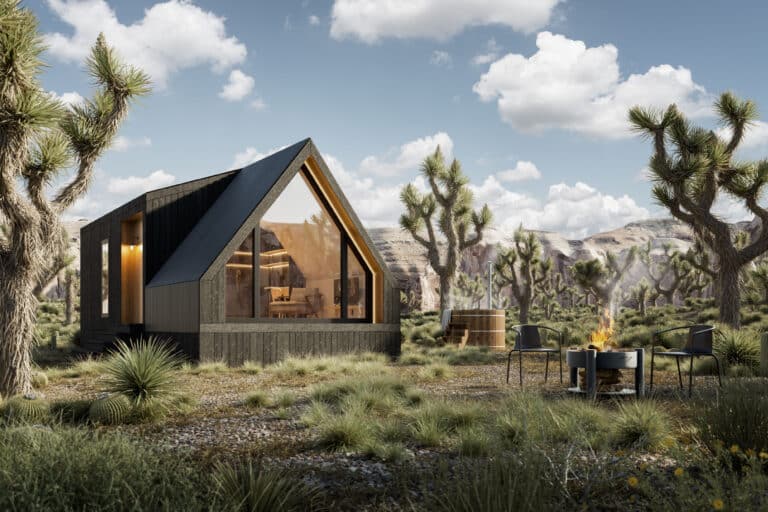
The A-Frame
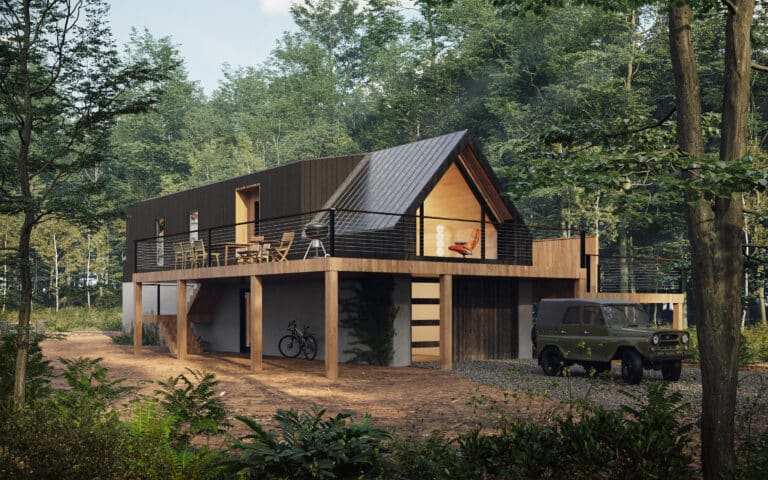
The A-Frame ADU

The A-Frame Bunkhouse

The A-Frame Cottage
What Is Considered An ADU in California?
According to the California ADU Handbook, an ADU is an attached or detached residential unit with permanent facilities for living, sleeping, eating, cooking, and sanitation. It must be designed to allow one or more people to live independently from the primary residence on a single-family or multifamily property.
Most areas in California allow attached, detached, conversion, and junior accessory dwelling units (JADUs). Some jurisdictions even permit tiny homes on wheels (THOWs) to qualify as ADUs. Since definitions and allowances vary by location, keep reading to learn how your locality defines an ADU.
If you think a tiny home might better fit your needs, read our article on California’s tiny home regulations to find out what’s allowed in your area.
Are JADUs the Same as ADUs?
Junior accessory dwelling units (JADUs) are a new ADU style that California has recently passed legislation allowing statewide. These units differ from a traditional ADU; for example, they may not exceed 500 square feet and are not legally considered the same as an ADU. If you want to learn more about these kinds of ADUs, watch the video above.
Can Park Model Tiny Homes Be Used As ADUs?
Some places in California, such as Mendocino County & the city of Los Angeles, permit movable tiny homes, or park model tiny homes, to be used as ADUs. However, other areas, like Amador & Calaveras Counties, strictly prohibit them from being utilized as ADUs. Because permissions can vary from place to place, it’s recommended that you contact your local planning, building, or zoning authority to determine what they allow.
If you reside in an area that permits them, browse the park models below. All models are larger than 150 square feet, which is the typical minimum sizing requirement for an ADU in California.

The A-Frame

The A-Frame Bunkhouse
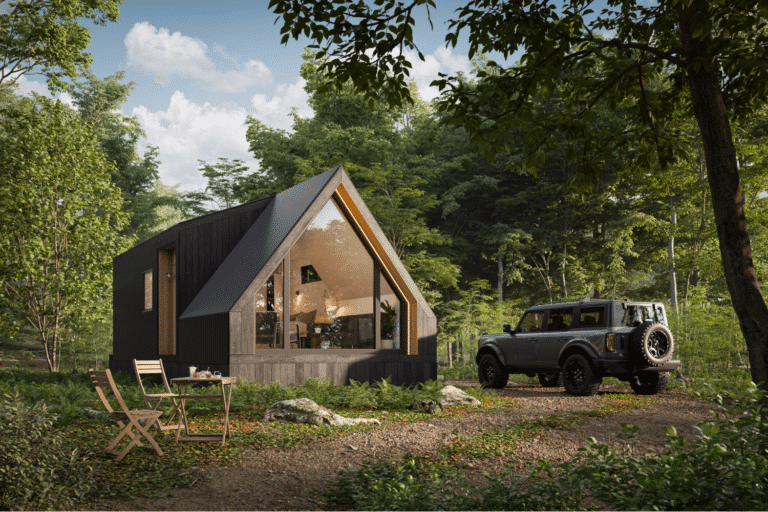
The A-Frame Studio

The Aspen
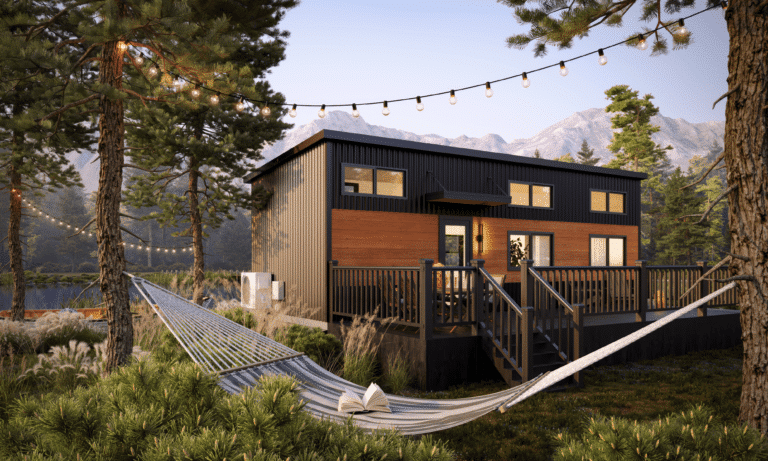
The Cascade

The Denali
Can Log Cabins Be Used As An ADU?
Yes, log cabins can be used as ADUs if they meet your area’s size and design requirements. Most ADUs in California range from 150 to 1,200 square feet, which many of our models fall within. Browse the options below to find the best fit for your property.
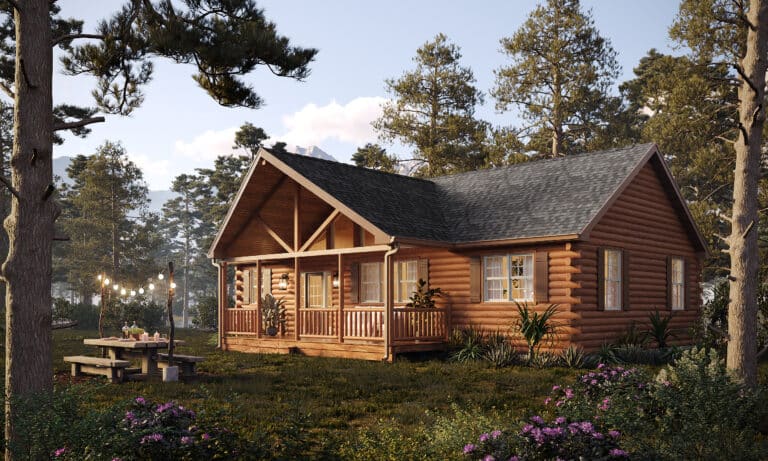
The Alpine
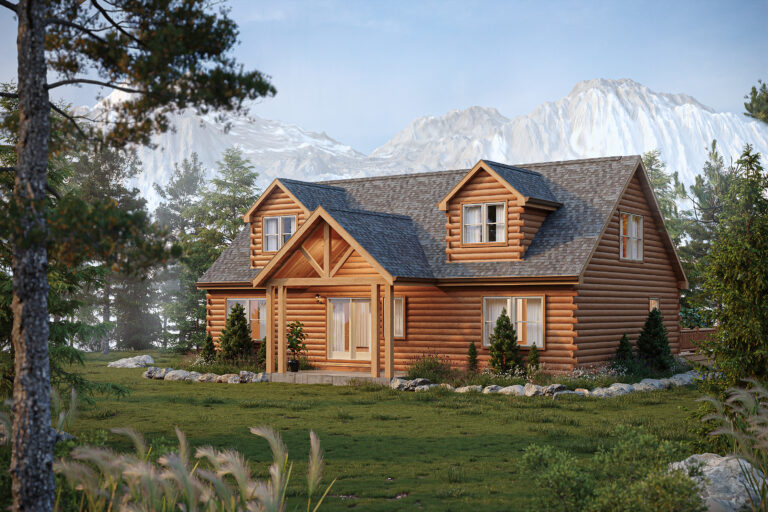
The Canyon Lodge
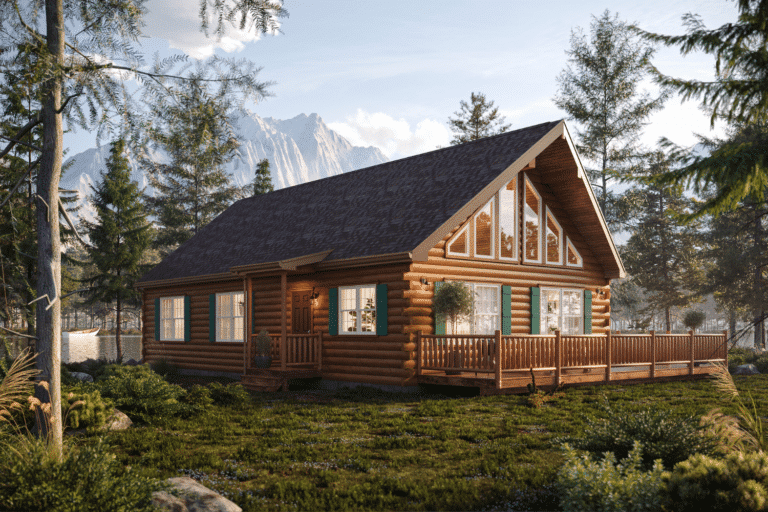
The Chalet
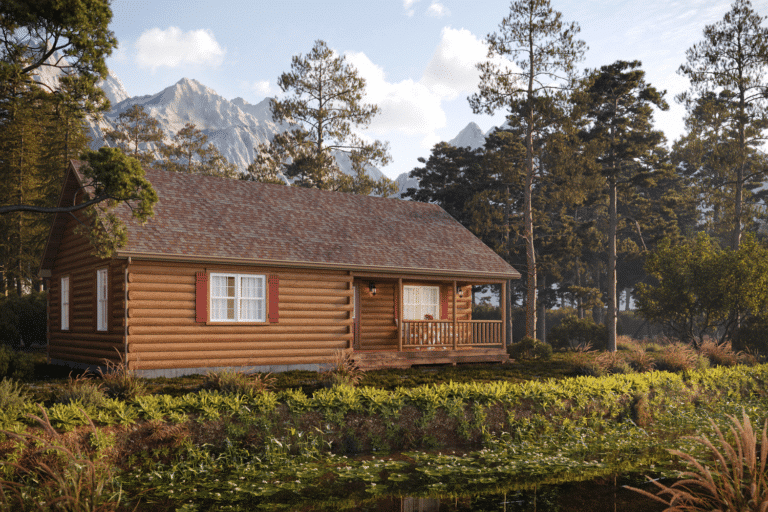
The Frontier
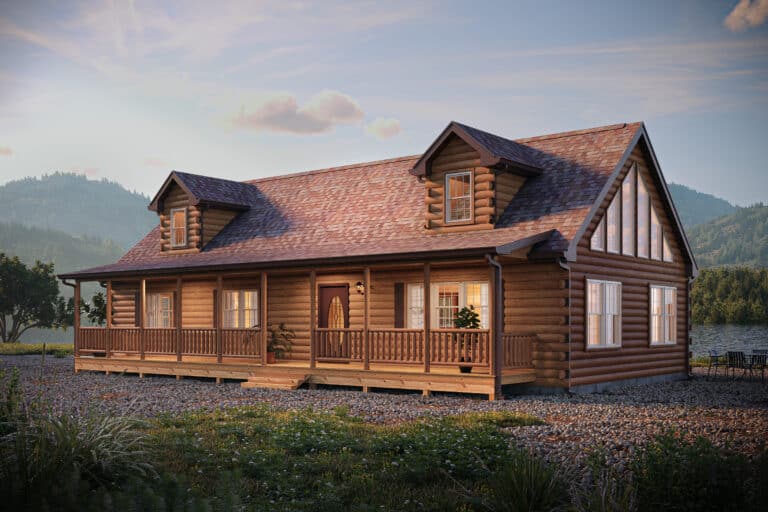
The Glacier

The Mountaineer
Can Modern Cabins Be Used As An ADU?
Our modern cabins can also be used as ADUs in California, as long as they meet your local size and design standards.
Most areas allow ADUs up to 1,200 square feet in size, making any of the cabins listed below a great fit for your property.

The Beck
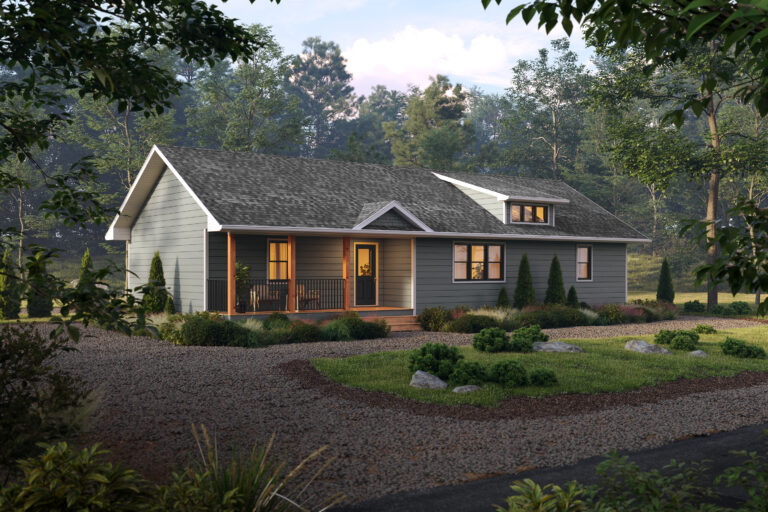
The Woodland

The Walden Stack

The Rivara

The Two Pines
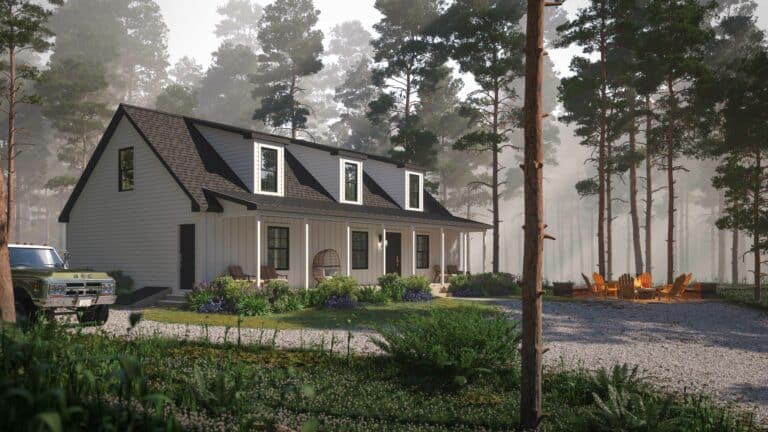
The Homestead
What is the Difference Between a Prefab ADU & a Modular ADU?
The defining difference between prefab and modular ADUs is where construction and assembly takes place.
Prefab ADUs are built entirely off-site and delivered to your property fully assembled. Modular ADUs, on the other hand, are constructed off-site in sections and must be assembled on-site.
If you want to learn more about the distinctions between the two, check out our comprehensive breakdown of prefab and modular ADUs.
Size & Placement Requirements

One of the defining characteristics of an accessory dwelling unit is that it must be smaller than the primary home on the lot. As a result, size and placement requirements are among the most important factors in getting your ADU plans approved. Below, we’ll take a closer look at these requirements.
What is the Minimum Size for an Accessory Dwelling Unit?
California requires every ADU to be at least 150 square feet, the minimum size for what the state defines as an “efficiency unit.” An efficiency unit is a living space that includes areas for sleeping, dining, cooking, and sanitation. However, some local jurisdictions may enforce a larger minimum size, so keep reading to ensure your ADU plans comply with local regulations.
Can My ADU be Bigger Than My House?
No, an ADU cannot be larger than the principal structure on your property. Most areas in California do not allow ADUs to exceed 1,200 square feet.
How Close To My House Can I Build An ADU?
According to state requirements, there must be a minimum setback from the side and rear property lines of at least 4 feet. Your zoning district typically determines exact setbacks for the side, rear, and front property lines, so be sure to check with your local zoning officials to certify compliance.
Do You Need A Permit For An ADU in California?
Yes, almost all ADUs will require a permit. Most areas require a building permit and some form of zoning or planning approval. Additionally, many localities require a well permit and proof that the property has its own water and sewage hookups. Some jurisdictions also issue an ADU-specific permit for these structures.
To ensure you’ve obtained all necessary approvals, contact your local planning, zoning, and building departments. Keep reading to find out what your area’s permit requirements are.
Are There Any Incentives or Grants for ADUs in California?

Yes, the California Housing Finance Agency offers an ADU grant program that can provide up to $40,000 to cover pre-development and non-recurring closing costs associated with ADU construction.
Additionally, many jurisdictions waive permit fees for certain ADU sizes or offer pre-approved plans that help reduce development costs. Below, we outline each county and several major cities, along with the appropriate officials to contact about these benefits.
What Features are Included in An ADU from Zook Cabins?
While exact features vary by model, all of our ADUs include:
- A range of bedroom and bathroom configurations to suit your needs
- High-performance insulation to help you stay cool during California’s hottest months
- A fully finished interior, making your unit nearly move-in ready once placed on a permanent foundation
- A dedicated kitchen space
- Built-in heating and cooling options
Additional features such as cabinetry, countertops, and tilework can be customized to match your preferences. Contact one of our sales representatives to explore your options.
Are Zook Cabin’s ADUs Built to Code?
Yes, all of our models are designed to meet local size and room requirements for accessory dwelling units. Because these are modular-built ADUs, they must be placed on permanent foundations to comply with local building codes.
If you have questions about which type of foundation is best for your needs, our team will be happy to help.
Can an ADU Have Multiple Bedrooms and Bathrooms?
Yes, some areas may permit only one bedroom and bathroom, but many places in California allow multiple bedrooms and bathrooms. Explore our Grove, Luna, and A-Frame models if you want an ADU with more space. Each offers one to two bedrooms and bathrooms.
Are ADUs A Good Investment?

ADUs are an excellent investment because they provide an additional source of income. They can be rented out and, depending on where you live, even sold separately from the primary residence. In addition, adding an ADU can increase your property’s overall value, boosting its resale potential if you decide to sell.
As noted, some areas have restrictions on owner occupancy and the ability to sell an ADU separately, so read on to learn what your locality allows.
What Are the Requirements for ADUs in Each County in California?
Below is a list of all 58 counties in California, along with their ADU requirements and the appropriate government officials to contact for questions or to certify your ADU plans. All areas in California, regardless of local government rules, must allow at least one ADU that is 800 square feet, 16 feet in height, and no more than 4 feet from the rear and side property lines. However, each county may enforce slightly different minimum and maximum size standards beyond the state baseline.
In addition, cities and towns may establish their own requirements as long as they comply with state law. If you do not live in an unincorporated area, you can skip this list and go directly to your city or town’s specific ADU guidelines.
| County | Contact | Allows ADUs? | Min. Sq. Ft. | Max. Sq. Ft. |
| Alameda | Alameda County Planning Department | Yes | Not stated | 1,200 sq. ft. or 50% of the primary structure’s floor area, whichever is less |
| Alpine | Alpine County Building Safety Division | Yes | 200 sq. ft. | 1,200 sq. ft. or 50% of the primary structure’s floor area, whichever is greater |
| Amador | Amador County Planning Department | Yes | 150 sq. ft. | 1,200 sq. ft. or 800 sq. ft./ 50% of the existing main home |
| Butte | Butte County Development Services | Yes | Not stated | No limit |
| Calaveras | Calaveras County Planning Department | Yes | 150 sq. ft. | 1,200 sq. ft. |
| Colusa | Colusa County Community Development | Yes | Not stated | Not stated |
| Contra Costa | Contra Costa County Building & Planning Department | Yes | Not stated | 1,000 sq. ft. |
| Del Norte | Del Norte County Planning Division | Yes | 150 sq. ft. | 1,200 sq. ft. |
| El Dorado | El Dorado County Planning Division | Yes | 220 sq. ft. | 1,200 sq. ft. |
| Fresno | Fresno County Planning & Land Use | Yes | Not stated | 1,000 sq. ft. or 50% of the primary dwelling |
| Glenn | Glenn County Planning Department | Yes | Not stated | No stated maximum (lot coverage applies) |
| Humboldt | Humboldt County Building & Planning | Yes | None | 1,200 sq. ft. |
| Imperial | Imperial County Planning & Development | Yes | Not stated | 1,200 sq. ft. (with CUP) |
| Inyo | Inyo County Planning Department | Yes | Not stated | 1,200 sq. ft. |
| Kern | Kern County Planning Department | Yes | Not stated | 1,200 sq. ft. or 50% of primary dwelling |
| Kings | Kings County Community Development Agency | Yes | Not stated | 1,000 sq. ft. heated + 1,000 sq. ft. unheated |
| Lake | Lake County Planning Department | Yes | Not stated | Not stated |
| Lassen | Lassen County Planning & Building Services | Yes | Not stated | Not stated |
| Los Angeles | Los Angeles County Planning Department | Yes | Not stated | 1,200 sq. ft. |
| Madera | Madera County Planning Division | Yes | Not stated | 1,000 sq. ft. or 50% of primary dwelling |
| Marin | Marin County Community Development | Yes | Not stated | 1,200 sq. ft. |
| Mariposa | Mariposa County Planning Department | Yes | 150 sq. ft. | 1,200 sq. ft. |
| Mendocino | Mendocino County Planning & Building | Yes | Not stated | 1,200 sq. ft. |
| Merced | Merced County Planning Department | Yes | Not stated | 1,200 sq. ft. |
| Modoc | Modoc County Planning Department | Yes | 150 sq. ft. | 1,200 sq. ft. |
| Mono | Mono County Planning Division | Yes | Not stated | 500–1,400 sq. ft. based on lot size |
| Monterey | Monterey County Planning Services | Yes | Not stated | 800 sq. ft. |
| Napa | Napa County Building Division | Yes | Not stated | Not stated |
| Nevada | Nevada County Planning Department | Yes | Not stated | 1,200 sq. ft. |
| Orange | Orange County Public Works | Yes | Not stated | 1,200 sq. ft. |
| Placer | Placer County Planning Services | Yes | Not stated | 1,200 sq. ft. |
| Plumas | Plumas County Planning Department | Yes | Not stated | 1,200 sq. ft. |
| Riverside | Riverside County Planning Department | Yes | Not stated | 1,000 sq. ft. |
| Sacramento | Sacramento Planning & Environmental Review | Yes | 150 sq. ft. | 1,200 sq. ft. |
| San Benito | San Benito County Planning Department | Yes | Not stated | 1,200 sq. ft. |
| San Bernardino | San Bernardino County Land Use Services | Yes | Not stated | 800 sq. ft. |
| San Diego | San Diego County Planning & Development | Yes | Not stated | 1,200 sq. ft. |
| San Francisco | San Francisco Planning Department | Yes | 220 sq. ft. | 600 sq. ft. (RH-1(S) only) |
| San Joaquin | San Joaquin County Community Development Department | Yes | Not stated | 1,000 sq. ft. |
| San Luis Obispo | San Luis Obispo County Planning & Building Department | Yes | 150 sq. ft. | 1,200 sq. ft. |
| San Mateo | San Mateo County Planning & Building Department | Yes | Not stated | 1,500 sq. ft. |
| Santa Barbara | Santa Barbara County Planning & Development Department | Yes | Not stated | 800–1,200 sq. ft. |
| Santa Clara | Santa Clara County Planning & Development | Yes | Not stated | 1,200 sq. ft. or 50% of the primary dwelling |
| Santa Cruz | Santa Cruz County Planning Department | Yes | 150 sq. ft. | 800–1,200 sq. ft. based on lot size |
| Shasta | Shasta County Planning Department | Yes | Not stated | 1,200 sq. ft. or 50% of the primary residence |
| Sierra | Sierra County Planning Department | Yes | Not stated | 1,200 sq. ft. |
| Siskiyou | Siskiyou County Planning Department | Yes | Not stated | Not stated |
| Solano | Solano County Planning Services | Yes | 380 sq. ft. | 1,200 sq. ft. |
| Sonoma | Sonoma County Planning Division | Yes | Not stated | 1,200 sq. ft. |
| Stanislaus | Stanislaus County Planning & Development | Yes | Not stated | 1,200 sq. ft. |
| Sutter | Sutter County Planning Services | Yes | Not stated | 1,200 sq. ft. or 50% of the primary dwelling |
| Tehama | Tehama County Planning Department | Yes | Not stated | 1,200 sq. ft. or 50% of the primary dwelling |
| Trinity | Trinity County Planning Division | Yes | Not stated | Not stated |
| Tulare | Tulare County Building & Planning Department | Yes | Not stated | Not stated |
| Tuolumne | Tuolumne County Development Department | Yes | Not stated | 1,200 sq. ft. or 50% of the primary dwelling |
| Ventura | Ventura County Planning Department | Yes | Not stated | 850–1,200 sq. ft. based on dwelling type |
| Yolo | Yolo County Planning Division | Yes | Not stated | 1,200 sq. ft. or 50% of the primary dwelling |
| Yuba | Yuba County Planning Department | Yes | 320 sq. ft. | 1,200 sq. ft. or 50% of the primary dwelling |
Does Alameda County Allow ADUs?
Yes, Alameda County allows ADUs, so long as they meet the following requirements:
- Maximum Square Footage:
- 50% of the principal dwelling unit’s floor area or 1,200 sq. ft., whichever is less, but only if 1 ADU is proposed
- 800 sq. ft. if there is also a JADU being added to the property
- Setbacks:
- Side & Rear Yard: Minimum of 4 feet
- Front Yard: Depends on zoning district
- Room Requirements:
- If you only plan to have 0-1 bedroom, your ADU can only be a maximum of 850 square feet
- For 2 or more bedrooms, your ADU can be a maximum of 1,200 square feet
Please contact the Alameda County Planning Department to confirm compliance with all applicable regulations. Many ADU standards depend on your property’s zoning, and the Planning Department can help determine which rules apply in your zoning district.
Does Alpine County Allow ADUs?
Alpine County allows ADUs provided that the proper permits are obtained. These include a building permit, well permit (or certification that the water supply can serve the ADU from your water provider), and verification from the Health Department that the watewater system is sufficient.
Additional requirements include:
- Minimum Square Footage: 200 square feet
- Maximum Square Footage:
- Conversion ADUs: none
- Detached ADUs: 1,200 sq. ft.
- Attached ADUs: 50% of the principal dwelling unit’s floor area or 800 square feet, whichever is more
- Setbacks:
- Rear and side property lines: 4 feet
- Front Yard: Based on zoning district
- Permits:
- Secondary Dwelling Unit Permit
- Well permit
To certify compliance with all applicable regulations, contact the Alpine County Building Safety Division.
Does Amador County Allow ADUs?
Yes, Amador County allows ADUs, outlining the following standards for acceptable ADUs:
- Number of Rooms:
- At least one kitchen, bathroom, and sleeping area
- May have multiple bedrooms depending on property size & location
- Minimum Square Footage: 150 sq. ft.
- RVs, Tiny Homes on Wheels (THOW), Yurts, and Storage Structures are not permitted as ADUs
- Maximum Square Footage:
- Attached ADU: 800 sq. ft. or 50% of the existing main home
- Detached ADU: 1,200 sq. ft.
- Setbacks:
- Side & Rear Yard: 4 feet
- Front Yard: Based on zoning district
Since ADU regulations in Amador County are often set by property size and zoning district, reach out the Amador County Planning Department to certify compliance with all applicable requirements for your property.
Does Butte County Allow ADUs?
Yes, Butte County allows ADUs and enforces no size restrictions for them. However, there are other requirements you must meet:
- Setbacks:
- Side & Rear Yard: 4 feet
- In State Responsibility Area: 30 to 100 feet
- Agricultural Budder Area: 300 feet
To ensure compliance with setback requirements, contact the zoning official at Butte County Development Services.
Does Calaveras County Allow ADUs?
Calaveras County does allow ADUs in zoning districts with single-family residences, so long as they meet these outlined requirements:
- Number Permitted: 1 ADU & 1 JADU
- ADUs cannot be Tiny Homes on Wheels, RVs, Yurts, or Storage Structures
- Minimum Square Footage: 150 sq. ft.
- Maximum Size:
- Detached & Attached: 1,200 square feet
- Conversion: no size limit
- Setbacks: Vary based on where you reside
ADU applications must be filed with Building Department. You can contact them at (209)-754-6390 with any questions or to ensure your application will be approved.
Does Colusa County Allow ADUs?
Yes, Colusa County does allow ADUs. Contact the Community Development Department to learn more about their requirements for adding one to your property.
Does Contra Costa County Allow ADUs?
ADUs are permitted in Contra Costa County, so long as they meet the following criteria:
- Permits:
- Building Permit
- Planning Approval
- Maximum Size:
- Detached ADU: 1,000 square feet
- Attached ADU: 1,000 square feet
- Maximum square footage may be less, depending on exactly what zoning district you reside in
- Permanent foundation required for all ADU
- Setbacks:
- Side & Rear Yard: 4 feet minimum
- Front Yard: Based on zoning district
To ensure you receive planning approval and are adhering to all zoning district requirements, contact the Contra Costa County Building & Planning Department.
Does Del Norte County Allow ADUs?
Yes, they do, so long as they meet the following criteria:
- Minimum Size: 150 square feet
- Maximum Size: 1,200 square feet
- Setbacks:
- Front: based on the zoning district
- Side & rear: 4 feet
- Separation between structures: 5 feet
- Maximum Height: 16 feet
- Tiny Homes on Wheels (THOWs) or Park Model Tiny Homes are not permitted as ADUs
Contact the Del Norte County Planning Division to ensure compliance with all outlined requirements. Please note that different requirements apply in coastal zones. If your property is located in one, contact the Planning Division to determine how the regulations differ.
Does El Dorado County Allow ADUs?
Yes, El Dorado County does allow ADUs so long as they meet the following sizing requirements:
- Minimum Size: 220 square feet
- Maximum Size: 1,200 square feet
Other requirements apply, but can vary depending on which zoning district your ADU will be located in. Contact the county’s Planning Division for more information.
Does Fresno County Allow ADUs?
Fresno does allow ADUs, so long as they meet the following requirements:
- Maximum Size:
- Detached ADUs With 1-bedroom: 850 square feet
- Detached ADUs With 2-bedrooms: 1,000 square feet
- Attached ADUs: Must match above requirements or be no more than 50% of the primary structure’s living area, whichever is less
- Maximum Number of Bedrooms: 2
Additional requirements regarding setbacks, utilities, and design may apply. Contact the Fresno County Planning & Land Use Department to ensure compliance with all applicable building standards.
Does Glenn County Allow ADUs?
Yes, but it’s important to note the following:
- There are no maximum size restrictions.
- A permanent foundation is required.
- Tiny homes on wheels (THOWs) or Park Model Tiny Homes are not permitted as ADUs.
To ensure your ADU plans will be approved, contact the Glenn County Planning Department.
Does Humboldt County Allow ADUs?
Humboldt County allows ADUs so long as they:
- Are no larger than 1,200 square feet
- Are a minimum of 4 feet from side & rear property lines
- Are NOT sold separately from the principal structure
- Are NOT used as short-term rentals
Review your plans with the Humboldt County Planning Department to ensure compliance with all applicable regulations.
Does Imperial County Allow ADUs?
Yes, ADUs are allowed in Imperial County under the following conditions:
- They are NOT sold separately from the principal structure.
- Only located in: Zones that allow residential uses
- Maximum Size: 50% of the existing living area or 850 square feet, whichever is larger, or 1,000 square feet if the ADU has more than one bedroom
- A detached ADU can be up to 1,200 square feet with a Conditional Use Permit (CUP)
- Setbacks: 4 feet from side and rear property lines
Contact Planning & Development Services to certify that your ADU plans meet all applicable regulations for your zoning district.
Does Inyo County Allow ADUs?
Yes, to build an ADU in Inyo County, you must:
- Ensure it’s no larger than 1,200 square feet
- It has it’s own address
- Obtain a building permit
ADu applications are submitted to the Inyo County Department of Building and Safety. Contact them at (760)-873-7857 to certify compliance with application requirements and building standards.
Does Kern County Allow ADUs?
Yes, Kern County allows accessory dwelling units that meet the following requirements:
- Minimum Size of Principal Dwelling Unit: 1,200 square feet
- Number of ADUs Per Lot: 1
- Maximum Size: 1,200 square feet
To certify compliance with all applicable regulations, contact the Kern County Planning Department.
Does Kings County Allow ADUs?
Yes, so long as they are no large than 1,000 square feet. To learn more about additional development standards, contact the Kings County Community Development Agency.
Does Lake County Allow ADUs?
Yes, so long as they mee the California Department of Housing & Community Development’s standards for accessory dwelling units.
Does Lassen County Allow ADUs?
Lassen County permits a “second housing unit”, but it’s unclear what requirements they must meet or if they are similar to ADUs. To learn more about this structure and whether or not an ADU would be allowed, contact the Lassen County Planning Commission.
Does Los Angeles County Allow ADUs?
Los Angeles County does allow ADUs so long as they are no larger than 1,200 square feet. To learn more about development and construction standards for ADUs within the county, contact the Los Angeles County Planning Department.
Does Madera County Allow ADUs?
Yes, Madera County allows ADUs that meet the following requirements:
- Maximum Size:
- Detached ADU: 850 sq. ft. for 1-bedroom or 1,000 sq. ft. for 1 bedroom or more
- Attached ADU: 50% of the existing primary dwelling or the 850/1,000 sq.ft. requirement based on the number of rooms, whichever is greater
- Setbacks:
- Front Yard: Depends on zoning district
- Side & Rear Yard: 4 feet minimum
Since requirements vary by zoning district, be sure to certify compliance with applicable regulations by contacting the Madera County Planning Division.
Does Marin County Allow ADUs?
Yes, Marin County allows ADUs under both state law and its own local requirements. ADUs subject to the county’s ADU Permit must meet the following standards:
- Maximum Size:
- Attached ADU: 50% of the floor area of the existing residence or 1,200 square feet, whichever is less
- Detached ADU: 1,200 square feet
Other standards apply, but can vary based on zoning district. Consult with the Marin County Community Development Agency to determine which rules apply.
Does Mariposa County Allow ADUs?
Mariposa County does allow ADUs under the California state requirements. This includes the following criteria:
- ADUs cannot be Tiny Homes on Wheels, RVs, Yurts, or Storage Structures
- Minimum Square Footage: 150 sq. ft.
- Maximum Size: 1,200 sq. ft.
Requirements can vary by zoning district. Reach out to the Mariposa County Planning Department to ensure compliance with all applicable regulations.
Does Mendocino County Allow ADUs?
Mendocino County allows ADUs up to a maximum of 1,200 square feet. Movable tiny homes and park model tiny homes are permitted as ADUs, provided they meet setback and other applicable requirements. Contact the Building Division or Planning Division to ensure your project complies with all regulations.
Does Merced County Allow ADUs?
Yes, and like most of California, your ADU can be no larger than 1,200 square feet and must have a minimum setback of 4 feet from side and rear property lines. To certify compliance with all applicable regulations, contact the Merced County Planning Department.
Does Modoc County Allow ADUs?
Yes, the county follows the state’s ADU requirements, which include the following:
- ADUs cannot be Tiny Homes on Wheels, RVs, Yurts, or Storage Structures
- Minimum Square Footage: 150 sq. ft.
- Maximum Size: 1,200 sq. ft.
- Setbacks: Vary based on where you reside
The Modoc County Planning Department can help you ensure that your ADU complies with all applicable requirements.
Does Mono County Allow ADUs?
Yes, and Mono County enforced the following standards for accessory dwelling units:
- Maximum Size:
| Property Sq. Footage | Maximum Sq. Footage |
| 7,500 square feet or less | 500 |
| 7,500 square feet to 10,000 square feet | 640 |
| 1 acre or more | 1,400 |
- Design Standards: Must be consistent with principal structure
The Mono County Planning Division will review your plans to ensure that your ADU meets all of their requirements.
Does Monterey County Allow ADUs?
Yes, and ADUs in Monterey County must be built in accordance with the following standards:
- Maximum Size: 800 square feet
- Setbacks: Minimum of 4 feet from side & rear property lines & consistent with fire/safety standards
To ensure compliance with all requirements, contact Monterey County Planning Services.
Does Napa County Allow ADUs?
Yes, ADUs are allowed. In general, the state rules apply. However, contact the Napa County Building Division to determine the exact sizing, placement, and zoning requirements your ADU must meet in order to be approved.
Does Nevada County Allow ADUs?
Yes, Nevada County allows ADUs in R1,R2, RA, AE, AG, FR, & TPZ zoning districts so long as they comply with the following requirements:
- # Per Property: 1 JADU & 1 ADU
- Maximum Size: 1,200 square feet
- Setbacks: A minimum of 4 feet from side & rear property lines
- Park model tiny homes are not permitted as ADUs
To ensure compliance with zoning district requirements, reach out to the Nevada County Planning Department.
Does Orange County Allow ADUs?
Orange County ADUs must meet the following requirements:
- Maximum Size: 1,200 square feet within the building site area or 800 square feet within the setback area where permitted
- Owner-Occupancy: Required
- Setbacks: 4 feet minimum from side and rear yard
- Maximum Height: 16 feet
- Placement: Not permitted in front yard
The Orange County Public Works Department will verify that your structure meets all applicable requirements, so be sure to contact them for approval.
Does Placer County Allow ADUs?
ADUs are allowed in Placer County so long as they are no larger than 1,200 square feet. Additional requirements regarding ADUs can be found on the Placer County FAQ page. Contact Placer County Planning or Building Services to certify compliance with all outlined requirements.
Does Plumas County Allow ADUs?
Yes, in all single-family residentially zoned areas. They can be no larger than 1,200 square feet. Additional requirements can be found through the Plumas County Planning Department.
Does Riverside County Allow ADUs?
Yes, so long as they comply with state requirements. Contact the Riverside County Planning Department to ensure compliance with all their ADU regulations.
Does Sacramento County Allow ADUs?
Yes, ADUs that comply with state minimum and maximum square footage requirements are permitted in Sacramento County. Contact the Sacramento County Planning Department to ensure compliance with all applicable regulations.
Does San Benito County Allow ADUs?
Yes, under California state law, you can have ADUs in San Benito County that meet the following requirements:
- Number of ADUs Per Property: 2
- Maximum Size: 800-1,200 square feet
- Setbacks: 4 feet from the side and rear property lines
- Maximum Height: 16 feet
Contact the San Benito Planning Department to ensure compliance with county requirements or keep reading to find out what your local requirements are.
Does San Bernardino County Allow ADUs?
Yes San Bernardino County allows ADUs in unincorporated areas, provided that they meet the following development standards:
- Maximum Size: 800 square feet
- Setbacks: 4 feet from the side and rear property lines
- Maximum Height: 16 feet
Residents in unincorporated areas should contact San Bernardino Land Use Services to ensure compliance with all requirements. If you reside within a city ot town’s jurisdiction, keep reading to learn what your local officials require.
Does San Diego County Allow ADUs?
The requirements for ADUs in San Diego County are based on the state requirements. This means that your ADU can be no larger than 1,200 square feet and that is must be setback at least 4 feet from side & rear yard lines.
Check with San Diego Planning & Development Services to certify compliance with all applicable requirements.
Does San Francisco County Allow ADUs?
Yes, the county does allow ADUs, so long as they are built in compliance with these sizing standards:
- Minimum Size: 220 square feet
- Minimum Ceiling Heights: 7.5 feet
- Maximum Size: 600 square feet in the RH-1 zone
Requirements vary by zoning district, so be sure to contact the Planning Department to ensure compliance with their regulations.
Does San Joaquin County Allow ADUs?
Yes, San Joaquin County permits ADUs so long as they meet the following requirements:
- Permits Obtained:
- Building permit
- ADU permit, if it is over 800 square feet
- Maximum Size:
- Detached ADU: 850 square feet or 1,000 square feet if there is more than 1 bedroom
- Attached ADU: 50% of the floor area of the primary dwelling
Reach out to the San Joaquin Community Development Department to obtain the required permits and certify compliance with all regulations.
Does San Luis Obispo County Allow ADUs?
San Luis Obispo County does allow ADUs, but requirements vary depending on whether you live in a coastal zone or an inland area. For example, the Cambria Community Services District boundary and the Los Osos Groundwater Basin boundary and plan area does not permit ADUs. However, the requirements for ADUs in inland areas are as follows:
- Minimum Size: 150 square feet
- Maximum Size: 1,200 square feet
- Setbacks: Must comply with zoning district requirements
To certify compliance with applicable regulations in your zoning district, contact the San Luis Obispo County Planning Department.
Does San Mateo County Allow ADUs?
San Mateo County allows ADUs, but like San Luis Obispo County, has different regulations depending on whether you live in a coastal or non-coastal zone. However, regardless of your zone, the following requirements apply:
- Maximum Floor Area:
- Detached ADUs: 800 square feet or 35% of the livable floor area of the existing or proposed primary structure, whichever is larger, up to a maximum of 1,500 square feet
- Attached ADUs: 800 square feet or 35% of the livable floor area of the existing or proposed primary structure, whichever is larger, up to a maximum of 1,500 square feet
- Setbacks:
- Side & Rear Property Lines: 4 feet
- Front Yard: Based on zoning district
Since requirements are based on your zoning district, we recommend contacting the San Mateo County Planning Department to learn more about what rules apply.
Does Santa Barbara County Allow ADUs?
Yes, Santa Barbara County allows ADUs, but exact requirements vary depending on whether you reside in an inland or coastal zone. However, the following requirements apply regardless of which zone you reside in:
- Maximum Size:
- Single-Family Zones: 800 square feet
- Multifamily Zones: 1,200 square feet
- Maximum Height: 16 feet
- Setbacks: Must comply with your zoning district’s requirements
- Design: Must be consistent with that of the primary dwelling
To certify compliance with requirements set by your zoning district, contact the Santa Barbara County Planning Department.
Does Santa Clara County Allow ADUs?
Santa Clara County’s ADU requirements are as follows:
- Maximum Size:
- Detached ADU: 1,200 square feet
- Attached ADU: 50% of the principal swelling unit’s square footage or 800 square feet, whichever is more
- Setbacks:
- Side & Rear Yars: 4 feet
- Front Yard: Based on zoning district
- Tiny homes on wheels or park model tiny homes are permitted as ADUs
It’s always best to contact the Santa Clara County Planning Department to ensure compliance with all requirements.
Does Santa Cruz County Allow ADUs?
Yes, in order to have an ADU in Santa Cruz County, it must be constructed in compliance with the following requirements:
- Park model tiny homes are not permitted as ADUs
- Permits:
- Building permit
- Additional permitting may be required to make changes to a non-conforming dwelling or for ADUs in the coastal zone
- Minimum Size: 150 square feet
- Maximum Size:
| Structure Type | Property Size | Maximum Square Footage |
| Attached ADU | Less than 1 acre | 850–1,000 sq. ft. or 50% of the primary dwelling, whichever is less |
| Greater than 1 acre | 50% of the primary dwelling’s floor area | |
| Detached ADU | Less than 1 acre | 800 sq. ft. (1 bedroom) or 1,000 sq. ft. (2+ bedrooms) |
| Greater than 1 acre | 1,200 sq. ft. |
Other construction standards may apply. Contact the Santa Cruz County Planning Department to ensure that all applicable requirements are met.
Does Shasta County Allow ADUs?
Yes. ADUs in Shasta County must comply with the following requirements:
- Number of ADUs Per Lot: 1
- Maximum Size: 1,200 square feet or 50% of the primary residence’s floor area, whichever is less
- However your ADU can be a maximum of 640 square feet regardless of the primary dwelling’s floor area
- Setbacks:
- Side & Rear Lot: 5 feet
- Front Lot: Based on zoning district
To certify compliance with zoning district standards, contact the Shasta County Planning Department.
Does Sierra County Allow ADUs?
Yes, provided that you adhere to the following:
- Number of ADUs: 2 ADUs
- Setbacks:
- Side & Rear Yard: 4 feet minimum
- Front Yard: Based on zoning district requirements
- Maximum Size: 1,200 square feet
To ensure compliance with all applicable requirements, contact the Sierra County Planning Department.
Does Siskiyou County Allow ADUs?
Yes, but specific requirements are not clearly outlined. Contact the Siskiyou County Planning Department for more information on what is allowed.
Does Solano County Allow ADUs?
Yes, and the county has the following building standards in place in order to add an accessory dwelling unit to your property:
- Minimum Size: 380 square feet
- Maximum Size:
- Attached ADU: 50% of the primary dwelling unit’s floor area up to 1,200 square feet
- Detached ADU:
- R-TC Zoning: 800-1,000 square feet, depending on the number of bedrooms
- R-R Zoning: 1,500 square feet
- Setbacks:
- Side & Rear Yard Lines: 4 feet
- Front Yard: Based on zoning districts
Since requirements vary based on zoning district, we recommend contacting Solano County Planning Services to ensure your ADU plans are approved.
Does Sonoma County Allow ADUs?
Sonoma County does allow them and outlines the following development standards for ADUs:
- Permits Required: Building Permit
- Maximum Size: 1,200 square feet
- Setbacks:
- Front Yard: Determined by zoning unless it would prevent an 800 square foot ADU
- Side & Rear Yard: Minimum 4 feet
For questions or to verify your ADU plans, contact the Sonoma County Planning Division.
Does Stanislaus County Allow ADUs?
Stanislaus County allows ADUs in the R-1 , R-2, R-3, R-A, P-D, and A-2 zoning districts in unincorporated parts of the county so long as they meet the following requirements:
- Maximum Size: 1,200 square feet
- Setbacks:
- Side & Rear Yard: 4 feet
- Front Yard: Based on your zoning district
- Maximum Height: Based on zoning district
- Can be sold separately: no
- Short-term Rentals: Not permitted
It’s always best to check with the Stanislaus County Planning Department to ensure that your ADU plans will be approved and to obtain required permits before beginning construction.
Does Sutter County Allow ADUs?
Yes, so long as accessory dwelling units adhere to the requirements outlined below, they are permitted in Sutter County. These requirements include:
- Permits: Zoning Clearance & Building Permit
- Number of Units: 1
- Maximum Size:
- Detached ADU: 1,200 square feet
- Attached ADU: 50% of the primary dwelling unit’s floor area or 1,200 square feet, whichever is less
To ensure compliance with all applicable regulations in the county, contact Planning Services.
Does Tehama County Allow ADUs?
Accessory dwelling units are permitted in Tehama County in the R-1, RE, AG-1, AG-2, AG-3, AG-4, and NR zoning districts, so long as they meet the following requirements:
- Maximum Size:
- Detached ADU: 1,200 square feet
- Attached ADU: 50% of the existing living area or 1,200 square feet, whichever is less
- Setbacks:
- Front Yard: Based on zoning
- Side & Rear Yard: 5 feet
- Owner-Occupancy: Required
If you reside in an unincorporated area, contact the Tehama County Planning Department to ensure compliance with their ADU requirements. If you live in a city or town within the county, keep reading to learn more about your requirements.
Does Trinity County Allow ADUs?
Yes. For a better understanding of the requirements for adding an ADU to your property within the county, contact the Trinity County Planning Division.
Does Tulare County Allow ADUs?
Tulare County does allow ADU but the specific development standards are unclear. Contact the Planning Department for clarification on what they allow.
Does Tuolumne County Allow ADUs?
Yes, provided that the following development standards are met:
- Maximum Size:
- Detached ADU: 1,200 square feet
- Attached ADU: 50% of the primary dwelling unit floor area or 1,200 square feet, whichever is less
- Required Rooms: Bathroom, kitchen, & living/dining room
- Setbacks:
- Side & Rear Yard: Minimum of 5 feet
- Front Yard: Based on zoning requirements
Since requirements are often based on your zoning district, it’s best to consult with the Tuolumne County Development Department to ensure compliance with all applicable regulations.
Does Ventura County Allow ADUs?
Ventura County does allow accessory dwelling units, so long as they meet the following requirements:
- Maximum Size:
- Detached ADU: 850 square feet on property with single-family dwelling, 1,200 square feet on properties with multifamily dwellings
- Setbacks:
- Side & Rear Yard: Minimum of 4 feet
- Permits:
- Building permit
- Zoning clearance
- Owner-Occupancy: Required
To certify compliance with Ventura County’s ADU requirements, contact the Planning Department.
Does Yolo County Allow ADUs?
Yes, but ADUs being constructed on a property in Yolo County must meet the following building standards:
- Minimum Height: 16 feet
- Setbacks for New Construction:
- Side & Rear Yard: 4 feet
- Front Yard: Based on zoning
- Building Separation: Detached structures must be at least 10 feet from the principal structure
- Maximum Size:
- Detached ADUs: 1,200 square feet
- Attached ADUs: 50% of the existing structure’s living area or 1,200 square feet, whichever is less
Contact the Yolo County Planning Division to ensure compliance with all their ADU requirements.
Does Yuba County Allow ADUs?
Yes, provided that they adhere to the following requirements:
- Park model tiny homes are not permitted as ADUs
- Minimum Size: 320 square feet
- Maximum Size: 1,200 square feet
- Rear/Side Setbacks: 4 feet
- Front/Street Setback: Based on the zoning district
To ensure compliance with all their ADU requirements, reach out to the Yuba County Planning Department.
Find Your Accessory Dwelling Units Requirements in California By Municipality
| City | Contact | Allows ADUs? | Min. Sq. Ft. | Max. Sq. Ft. |
| Anaheim | Planning & Building Department | Yes | 150 | 800-1,200 square feet, depending on the size of the principal dwelling |
| Bakersfield | Building Division | Yes | 150 | 50% of the primary dwelling unit floor area or 1,200 square feet |
| Long Beach | Building & Safety Bureau | Yes | 150 | 50% of primary floor area or 800 sq. ft., whichever is more, or 1,200 sq. ft. for detached ADUs |
| Los Angeles | Department of Building & Safety | Yes | 150 | 1,200 or 50% of the primary dwelling’s floor area, depending on the type of ADU being added |
| Sacramento | Building Division Contacts | Yes | Not stated | 1,200 |
| Oakland | Planning & Building Department | Yes | 150 | 850-1,000 square feet, depending on the number of rooms |
| San Diego | Development Services | Yes | 150 | 1,200 |
| San Francisco | Planning Department | Yes | 220 | 600 |
| San Jose | Planning, Building, & Code Enforcement Office | Yes | 150 | 1,200 |
Does Anaheim Allow ADUs?
Yes, Anaheim does permit ADUs, and they outline the following requirements for adding one to your property:
- Minimum Size: 150 square feet
- Maximum Size: 800–1,200 square feet depending on type of ADU and size of principal dwelling unit
- Short-Term Rental: Not permitted
- Owner-Occupancy: Required
Since requirements often vary by zoning district and the specifics of your ADU plans, contact the Anaheim Planning & Building Department to ensure your project will be approved.
Does Bakersfield Allow ADUs?
Accessory dwelling units are allowed in Bakersfield, so long as they are constructed in the following manner:
- Permits Obtained:
- Planning Application & Site Plan
- Building Permit
- Maximum Size:
- Attached ADU: 50% of the floor area of the existing primary dwelling, but no less than state maximum requirements
- Detached ADU: 1,200 square feet
- Short-Term Rentals: Not allowed
- Owner-Occupancy: Only required if JADU is being added
Does Long Beach Allow ADUs?
Yes, ADUs are allowed in residential zoning districts where single-family or multi-family residential uses are permitted. They must adhere to the following requirements:
- Number of ADUs Allowed: 1
- Minimum Size: 150 sq. ft.
- Maximum Size:
- Detached ADU: 1,200 square feet
- Attached ADU: 50% of primary floor area or 800 sq. ft., whichever is more
- Setbacks:
- Front & Street Side Yards: Based on zoning districts
- Interior Side or Rear Yards: Minimumof 4 feet
- Owner-Occupancy: Not required unless adding a JADU
Since requirements are largely based on zoning district, contact the Building & Safety Bureau to ensure compliance with zoning regulations.
Does Los Angeles Allow ADUs?
Yes, provided that they are built to meet the following standards:
- Minimum Size: 150 square feet
- Maximum Size:
- Detached ADU: 1,200 square feet
- Attached ADU: 50% of the primary dwelling’s floor area
- However, it cannot be less than 850 square feet for a 1-bedroom or 1,000 square feet for a multi-bedroom ADU
- Movable tiny houses are permitted as ADUs
Reach out to the Department of Building & Safety to obtain required permits and get approval on your ADU plans.
Does Sacramento Allow ADUs?
The city of Sacramento does allow ADUs, and outlines these requirements for adding one to your property:
- Number Per Lot: 2
- Maximum Size: 1,200 square feet
- Requirements differ for attached ADUs based on your ADU plans
Since requirements can vary depending on the specifics of your ADU plans, contact the Building Officials to obtain approval.
Does Oakland Allow ADUs?
Yes, the city of Oakland does allow accessory dwelling units, so long as they meet the following development standards:
- Permits Required: Zoning & Planning
- Number Per Lot: 1
- Minimum Size: 150 square feet
- Maximum Size: 850-1,000 square feet depending on the number of rooms
- Setbacks:
- Side & Rear Lot Lines: 4 feet
- Front Yard: Based on zoning district
To certify compliance with all applicable regulations and obtain permit permit approval, contact the Planning & Building Department.
Does San Diego Allow ADUs?
San Diego allows accessory dwelling units, so long as they comply with the following criteria:
- Minimum Size: 150 square feet
- Maximum Size: 1,200 square feet
- Setbacks:
- Front Yard: Based on the zoning district
- Side & Rear Yard: 4 feet minimum
Additional requirements may apply, contact Development Services to ensure compliance with all their requirements.
Does San Francisco Allow ADUs?
Yes, San Francisco allows accessory dwelling units, if they meet the same criteria as the county:
- Minimum Size: 220 square feet
- Minimum Ceiling Heights: 7.5 feet
- Maximum Size: Only the RH-1(S) zoning district outlines a maximum size, which is 600 square feet
Contact the Planning Department to ensure compliance with all applicable requirements, particularly those related to your zoning district.
Does San Jose Allow ADUs?
San Jose does allow accessory dwelling units and outlines the following requirements for them:
- Park model tiny homes are permitted as ADUs
- # of ADUs Per Property: 1
- Minimum Size: 150 square feet
- Maximum Size: 800-1,200 square feet depending on lot size and type of ADU
- # of Bedrooms/ Bathrooms: No maximums
Additional requirements apply and are often set based on your zoning district. Reach out to the San Jose Planning, Building, & Code Enforcement Office.
Searching For An ADU Builder Serving California?
One of the key takeaways from California’s ADU regulations is that size, placement, and the number of rooms all play a role in getting your ADU plans approved. While many areas offer pre-approved plans, these options often lack the flexibility to truly make the space your own.
Zook Cabins is an excellent choice if you’re looking for a builder that can help you meet local requirements while still offering a wide range of floor plans, customizable features, and fully finished interiors.
All of our ADU models range from 571 to 800 square feet, comfortably within the limits allowed by state law. Models like the Grove, A-Frame, and Luna offer multiple bedrooms and bathrooms. You can even contact a sales representative to discuss custom options for cabinetry, countertops, and tilework.
If one of our ADU models isn’t quite your style, consider our park models, log cabins, or modern cabins, which can be used as ADUs in many areas across the state. Contact us or request a quote to get started on your ADU today.
Tiny Home & ADU Rules By State: How Do They Compare?
California has some overlap between its tiny home and ADU regulations, with certain areas allowing park model tiny homes to be used as ADUs. Additionally, both tiny homes and ADUs are permitted throughout the state. However, the specific requirements can still vary by location.
If you’re curious to learn more about tiny home laws in California or across the U.S., check out the chart below.
